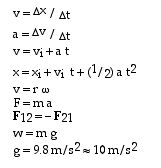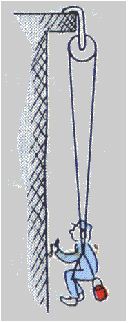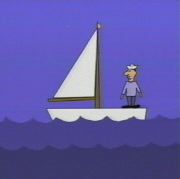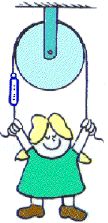For every question, also consider the following as a possible answer:
e) none of the above
Possibly useful information:

Excursions in Physics
PHY 3050G
First Hour Exam
February 5, 2003
Enter all your answers in the "scantron sheet" or the "bubble sheet". Turn in only that sheet. Anything you write on this exam will not be seen or used or considered or graded. Be sure your name is on the "bubble sheet" you hand in. Be sure your name is bubbled-in. Be sure your answers are recorded correctly.
Please come to class Friday. I will have a memo for each of you showing what I have recorded for your online quizzes. That may or may not agree with WebCT. What I have recorded is all that really counts. Let me know if my own gradebook needs to be changed.
For every question, also consider the following as a possible answer:
e) none of the above
Possibly useful information:

![]()
| Back to Excursion's Calendar |
![]()
For every question, also consider the following as a possible answer:
e) none of the above
1. What is the nature of Nature? In the absence of a net froce from the outside, an object
a) will fall to the ground.
b) always comes to rest.
c) will continue to do what it is doing.
d) pushes back on nearby objects.
2. In the absence of a net force from the outside, an object in motion
a) slowly comes to rest.
b) falls to the ground wit constant acceleration.
c) remains in motion along a straight line.
d) moves in a curved path at constant speed.
3. Kinematics is a description of motion. Motion was first well understood
a) by Aristotle and the ancient Greeks
b) by Ptolemy in Egypt
c) by Galileo in Italy
d) not until the beginning of the twentieth century
4. To measure the time needed to investigate motion,
a) Aristotle used a sundial
b) Ptolemy used the pendulum clock which had just been invented
c) Galileo invented his own water clocks
d) Newton invented the pendulum clock
5. Galileo was given a lifetime pension by the “city fathers” of Venice because he introduced
a) the pendulum clock.
b) the water clock.
c) the telescope.
d) the sun dial.
6. Galileo entered the University and first planned to study
a) theology
b) medicine
c) islamic studies
d) geography
7. Galileo took a position as a professor of mathematics and taught
a) Euclid’s geometry
b) Newton’s differential calculus
c) von Liebnetz’ integral calculus
d) Rubick’s cubism
8. Velocity is the time rate of change of
a) acceleration
b) speed
c) displacement
d) momentum
9. To calculate the average speed of an object, we need to know
a) force and mass.
b) distance and time.
c) distance and mass.
d) force and time.
10. Acceleration is the time rate of change of
a) velocity
b) displacement
c) distance
d) momentum
11. Acceleration might be described as telling
a) where an object is located relative to an origin or reference point. (No, that’s displacement).
b) how fast something is moving. (No, that’s velocity).
c) how fast something is getting faster.
d) how long an object has been moving. (No, that’s time).
12. What is the average speed of a motorcycle that travels 100 m in 20 s?
a) 20 m/s
b) 10 m/s
c) 5 m/s
v = 100 m/20 s
v = 5 m/s
d) 200 m/s
13. What is the average speed of a car that travels 125 km in 5 h?
a) 625 km/h
b) 25 km/h
v = 125 km / 5 h
v = 25 km / h
c) 10 km/h
d) 9.8 km/h
14. Consider a train that has an acceleration of 3 m/s2. Initially, at time t = 0, it has a velocity of vi = 20 m/s. What is its speed at t = 3 s?
a) 57 m/s
b) 41 m/s
c) 29 m/s
v = vi + a t
v = 20 m/s + (3 m/s2)(3 s)
v = 20 m/s + 9 m/s
v = 29 m/s
d) 9 m/s
15. Consider a car that starts at rest and accelerates at 2 m/s2
for 4 seconds.
At that time, t = 4 s, how fast is it going?
a) 16 m/s
b) 12 m/s
c) 8 m/s
v = vi + a t
v = 0 + (2 m/s2)(4 s)
v = 0 + 8 m/s
v = 8 m/s
d) 4 m/s
16. Consider a car that starts at rest and accelerates at 2 m/s2
for 4 seconds.
At that time,, t = 4 s, how far has it gone?
a) 32 m
b) 24 m
c) 16 m
x = xi + vi t + (1/2) a t2
x = 0 + 0 + (1/2) (2 m/s2)(4 s)2
x = 16 m
d) 8 m
17. Consider a ball that is thrown upward at the edge of a canyon with an initial
velocity of 30 m/s. Four seconds later, what is its velocity?
a) 40 m/s
b) 20 m/s
c) – 10 m/s
v = vi + a t
v = 30 m/s + ( - 10 m/s2)(4 s)
v = 30 m/s - 40 m/s
v = - 10 m/s
d) – 30 m/s
18. Consider a ball that is thrown straight upward at the edge of a canyon with
an initial velocity of 30 m/s. Four seconds later, where is it
located? Take its initial position, at the edge of the canyon, to be the origin;
that is, yi = 0.
a) 40 m
y = yi + vi t + (1/2) a t2
y = 0 + (30 m/s)(4 s) + (1/2)( - 10 m/s2)(4
s)2
y = 0 + 120 m - 80 m
y = 40 m
b) 20 m
c) – 10 m
d) – 30 m
19. A stone is dropped (from rest) from a bridge, high above a river. The stone takes five seconds before it hits the river. How fast is it going when it hits the water?
a) 5 m/s
b) 10 m/s
c) 50 m/s
v = vi + a t
v = 0 + ( - 10 m/s2)
v = - 50 m/s
The minus sign means it is going down.
d) 100 m/s
20. Newton's First Law of Motion states that, in the absence of a net force, an object in motion will
a) eventually come to rest
b) continue in motion but slow down until it stops
c) continue in motion with the same speed along the same straight line
d) continue along the same straight line with a decrease in speed
21. Newton's Second Law of Motion explains the cause of motion and may be stated as
a) "All motion is relative."
b) "All objects fall with the same velocity."
c) "The acceleration of an object is proportional to the net force on the object and inversley proportional to the object's mass."
a = F/m
That can then be turned around to our more familar form of
F = ma
d) "The acceleration of an object is proportional to the product of the object's mass and the net force on it."
22. Newton's Second Law of Motion explains the cause of motion and may be stated as
a) The net force on an object is inversely proportional to its weight.
b) The net force on an object produces an acceleration that is proportional to the time of action of that force.
c) The net force on an object is equal to the product of the mass of that object and its acceleration.
That is F = ma directly.
d) The net force on an object is inversely proportional to the mass of the object.
23. Mass is a measure of
a) the volume of an object
b) the size of an object
c) how difficult it is to change the motion of an object
d) the velocity of an object
24. The weight of an object is
a) the same thing as the mass of an object
b) the sum of all the forces on an object
c) the force of gravity on an object
d) always less than the mass, even in a vacuum
25. The net force on a 1-kg object, at rest, is
a) 9.8 N
b) 4.9 N
c) 1.00 N
d) zero
The net force on any object at rest is zero.
26. The net force on a 1-kg object, in free fall, is
a) 9.8 N
In free fall, the only force on an object is the force of gravity, its weight,
w = mg
w = (1.0 kg)(9.8 m/s2)
w = 9.8 N
b) 4.9 N
c) 1.00 N
d) zero
27. Harry the Painter has a weight of 500 N. When he is suspended as shown in the sketch here, what is the tension in the rope?

a) 1000 N
b) 500 N
c) 250 N
Both ends of the rope are attached to Harry’s bo’sun’s chair. Each end
of the rope exerts a force up on Harry. Each end of the rope exerts a
force equal to the tension in the rope. Harry’s weight is 500 N so each
end of the rope pulls up with half his weight, 250 N.
d) 25 N
28. A force of 24 N acts on an object whose mass is 8 kg.
This causes the object to accelerate at
a) 2 m/s2
b) 3 m/s2
F = ma
24 N = (8 kg)( a )
24 N = (8 kg)(3 m/s2)
a = 3 m/s2
c) 6 m/s2
d) 12 m/s22
29. A car, with mass of 1,000 kg, accelerates at 2 m/s2.
The net force exerted on the car must be
a) 500 N
b) 1,000 N
c) 2,000 N
F = ma
F = (1000 kg)(2 m/s2)
F= 2000 N
d) 10,000 N
30. The weight of a 1,000-kg car is
a) 500 N
b) 1,000 N
c) 2,000 N
d) 10,000 N
w = mg
w = (1000 kg)(10 m/s2)
w = 10,000 N
31. A fireman, whose weight is 500 N, slides down a pole with an acceleration of 3 m/s2. The forces that act on him are his weight pulling him down and the force of friction pulling up on him to slow him down. The force of friction must be
a) 90 N
b) 150 N
c) 350 N
We will need to use F = ma so we need to start by finding the fireman’s mass;
w = m g
500 N = ( m )(10 m/s2)
500 N = ( 50 kg ) (10 m/s2)
m = 50 kg
Now we can ask about the forces that act on this 50-kg mass;
Fnet = w - Ffrict
Fnet = 500 N - Ffrict
Fnet = m a
Fnet = (50 kg)(3 m/s2)
Fnet = 150 N
Fnet = 500 N - Ffrict = 150 N
500 N - ( 350 N ) = 150 N
Ffrict = 350 N
d) 500 N
32. If a sailor drops a wrench from the top of a tall mast on a moving ship, it will fall and hit the deck

a) in front of the base of the.
b) at the base of the mast.
c) behind the base of the mast.
33. Sir Isaac Newton
a) first discovered the Law of Falling Bodies while at the University of Pisa.
b) was a close friend of Liebnitz and encouraged his early development of calculus.
c) made great advances in Mechanics, Gravity, Optics, and Mathematics.
d) used water clocks of his own invention to aid sailors in determining their longitude.
34. Galileo
a) may be called the Father of Modern Optics.
b) wrote his findings in Polish while at the University of Paduah.
c) may be called the Father of Modern Science.
d) wrote his findings about Gravity and explained calculus.
35. The hallmark of Modern Science is that
a) theories are accepted or rejected based upon the background or reputation of the scientists who propose them (horrors!)
b) predictions of theories must be tested by and agree with experimental results.
c) theories must have elegant mathematical equations.
d) predictions of theories must not contradict established authorities (such as Plato or Pythagores)
36. When applying Newton's Second Law of Motion, F = ma,
a) F is always the largest force present.
b) F is always the net force -- or the sum of all the forces present.
c) m is always the largest mass in the system.
d) m must be the smallest mass in the system.
37. When using Newton's Third Law of Motion, F12 = - F21, the two forces
a) always cancel so this applies only to systems in equilibrium.
b) always act on different objects.
c) must act on the same object.
d) are always perpendicular to each other.

38. What value will the spring scale read in the system shown above? Little Nellie Newton weighs 50 N.
a) zero
b) 25 N
This is similar to the question about Harry the Painter. Nellie’s weight of 50 N
pulls down. The force on each hand, pulling up on her, must be one-half her weight
This is the tension in the rope, 25 N. This is exactly what the spring scale reads,
25 N
c) 50 N
d) 100 N
39. What is the net force on a 2-kg laboratory cart which accelerates at 3 m/s2?
a) 2 N
b) 3 N
c) 6 N
F = ma
F = (2 kg)(3 m/s2)
F = 6 N
d) 12 N
40. Consider a 2-kg lab cart which has an initial velocity of 5 m/s and then accelerates at 3 m/s2 for four seconds. At that time, t = 4 s, how fast is it moving?
a) 20 m/s
b) 17 m/s
v = vi + a t
v = 5 m/s + (3 m/s2)(4 s)
v = 5 m/s + 12 m/s
v = 17 m/s
c) 12 m/s
d) 8 m/s
41. Consider a 2-kg lab cart which has an initial velocity of 5 m/s and then accelerates at 3 m/s2 for four seconds. At that time, t = 4 s, how far has it moved?
a) 48 m
b) 44 m
x = xi + vi t + (1/2) a t2
x = 0 + (5 m/s)(4 s) + (1/2)(3 m/s2)(4 s)2
x = 0 + 20 m/s + 24 m/s
x = 44 m/s
c) 32 m
d) 24 m
42. In the absence of air resistance,
a) heavier objects fall with a greater acceleration than lighter objects.
b) heavier objects fall with the same acceleration as lighter objects.
c) heavier objects fall with a smaller acceleration than lighter objects.
43. A roller coaster is launched from rest to 28 m/s (that’s about 100 km/h or 60 mi/h) in 3.5 seconds. That is an acceleration of
a) 2 m/s2
b) 4 m/s2
c) 8 m/s2
a = change in velocity / change in time
a = (28 m/s)/(3.5 s)
a = 8 m/s2
d) 12 m/s2
44. A particular roller coaster is launched with an acceleration of 5 m/s2. What is the net force required to launch a 1,000-kg car?
a) 200 N
b) 1,000 N
c) 5,000 N
F = m a
F = (1000 kg)(5 m/s2)
F = 5000 N
d) 10,000 N
45. A force of 12 N is applied to a laboratory cart and an acceleration of 3
m/s2 is observed. The mass of the lab cart is
a) 2 kg
b) 4 kg
F = m a
12 N = ( m ) (3 m/s2)
12 N = ( 4 kg ) (3 m/s2)
m = 4 kg
c) 8 kg
d) 36 kg
46. When any object moves in a circle
a) its speed must decrease
b) its acceleration continues to change direction
c) its velocity is directed toward the center of the circle
d) its acceleration is tangent to the circle
47. The net force on any object which moves in a circle
a) causes the speed to increase.
b) is directed along a line tangent to the circle.
c) increases as the object slows down.
d) points toward the center of the circle.
48. Newton’s Third Law of Motion explains how two objects interact and
may be stated as
a) "All motion is relative."
b) "All objects fall with the same velocity."
c) "You cannot touch without being touched."
d) "The acceleration of an object is proportional to the product
of the object's mass and the net force on it."
49. The hallmark of Modern Science is that
a) theories are accepted or rejected based upon the background or reputation
of the scientists who propose them.
b) predictions of theories must be tested by and agree
with experimental results.
c) theories must have elegant mathematical equations.
d) predictions of theories must not contradict established authorities (such
as Plato or Pythagores).
50. The four fundamental forces are
a) friction, weight, centripetal, inertial
b) friction, air resistance, centrifugal, weight
c) gravity, electromagnetic, strong nuclear, weak nuclear
d) gravity, electromagnetic, strong contact, weak friction
![]()
| Back to Excursion's Calendar |
![]()